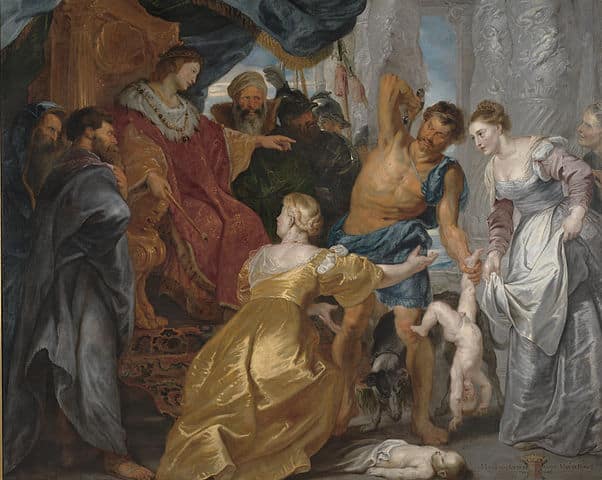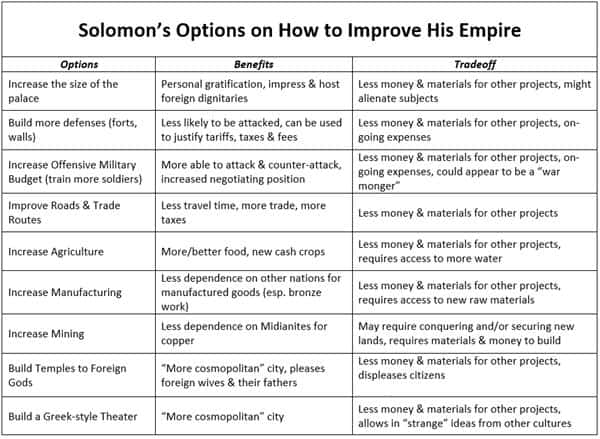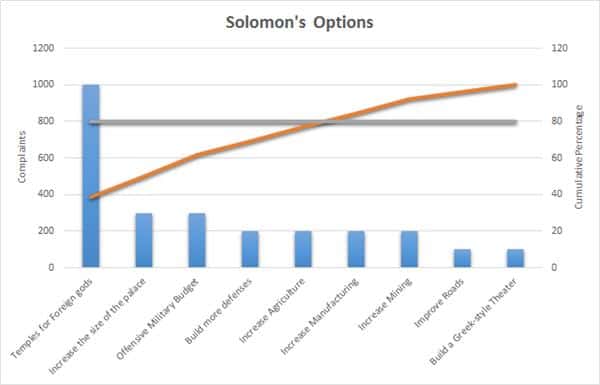SixSigmaStudyGuide.com note: In this article Jeremy and George turn to literary and religious tradition to illustrate how wise rulers could have benefited by tools we study and apply in preparation for our credentialing exams. This is a different article than Jeremy’s previous posts on how using Six Sigma principles changed his life and those of his students. Admittedly I was hesitant to publish this article. While this article in no way promotes or denigrates any belief system in any way, but instead explores potential application of Six Sigma tools in a novel way, religion and the internet tend not to mix well. I chose to publish because this audience is a mature and sharing one that I trust to take what they find valuable from the article and disregard the rest. If there are any concerns or comments, please contact me. If you would like to submit an article for publication, please contact me, too.
Now on to Jeremy and George.
In my previous posts I described the way in which Lean Six Sigma’s underlying ideas and ideals taught me that much of the world around me was in fact the result of processes — process that I could at least partially modify. That realization has empowered and strengthened me as well as bringing me renewed hope.
Unfortunately hope is not enough. Tools are needed in order to effectively change the world around us.
- Tools that help identify when a problem has occurred:
- Tools to determine what the problems truly are:
- Determine which problems (or causes of a problem) to work on first:
I did not find good example applications of Pareto charts during my online search, so I turned to some of my favorite literature for inspiration – the stories of the Christian Old Testament (which are copied from Jewish texts).
King Solomon is considered by many literary and religious traditions to be among the very wisest men to have ever lived. The Bible describes his first day as king, in which he makes many sacrifices and prays. That night he has a dream in which God asks Solomon what he wants, Solomon replies that he wants knowledge and wisdom so that he can rule his people correctly [1 Kings, Chapter 3].
In his most famous ruling, two women come to him; both claim that the living baby is her own and that the dead baby belongs to the other one. To the shock of many, Solomon asks for a sword and offers to cut the baby in half so that each mother could have half of a baby. One woman shouts that this is a good idea, saying that if she can’t have the baby then no one will. The other woman pleads for the baby to not be harmed. King Solomon gives the baby to this second woman – BUT the Bible does NOT actually state that this second mother was the biological mother of the baby. Instead it makes the point that Solomon used a shocking situation to gain deep information about the two women and then awarded the baby to the one that would be the best mother.

First Kings as well as Second Chronicles describes how the kingdom continued to grow and prosper while Solomon focused his building campaigns on projects that would provide military and financial security and how the kingdom began its decline when he began focusing his building campaigns on temples to foreign gods. This last part can be read two ways. In one interpretation, God stops blessing Solomon and his kingdom once immoral choices are made. In the second interpretation, Solomon as a project manager begins to choose projects from the “trivial many” projects (in this case building temples in attempt to please a relatively small number of people) rather than focusing on the “critical few” projects (in this case military defenses, securing trade routes, and investing in mining and agriculture). As a religious text, the first interpretation is clear and valuable. As a potential historical text, the second interpretation is also clear, and I believe also a source of valuable insight into how to govern.
Solomon’s son Rehoboam began and nearly ended his reign with a single poorly made decision. 1 Kings Chapter 12 describes how Rehoboam came to the throne after his father’s death and how his people immediately asked him to lighten taxes and lower the amount of military conscription. The next few verses describe a scene that could be straight out of a modern manual on how to be a CEO.
Rehoboam tells them that he will need three days to make his decision; during those three days he first consults the experts hired by his father and then the experts that he has selected himself. The younger experts point out that any new project manager or supervisor must establish his authority and identity and must not appear weak at the beginning of a new job. While this is absolutely true (and is similar to what we tell new teachers), this can be done several different ways and is not as important as other factors. Rehoboam chose to make a threatening and harsh statement as his response on that third day. As a result, his kingdom was split in two. It is this very act of poor management that caused Judah and Israel to be separate kingdoms during the rest of the books of Kings and Chronicles.
Joseph and Daniel are described as having insights into dreams and both were placed into positions of great authority. Joseph is described as hearing the pharaoh’s dream, going off to pray and then returning with advice to maximize the nation’s grain production and grain storage – advice that the pharaoh acted upon and in so doing saved a great many lives. Daniel is similarly described as listening, gathering as much information as possible, retiring to pray (and possibly study), and then returning with answers that changed the course of history. Daniel is then described as having been placed in authority over the other “wise men” and has also been described as a great leader.
We would like to also point out that many other quality assurance principles are similarly demonstrated by Biblical characters. Methods like “Go-See” (Gemba walks) and asking for facts (known as “the 5 whys”) are both demonstrated in “Old Testament” Bible stories (Jewish tradition is actually to ask seven times). The principle of “effect-cause-effect” (a key component of Goldratt’s Theory of Constraints) is even exemplified by some of the prophets, kings, and judges. As an educational example text, the Bible can teach us a lot!
In each of those cases the historical characters gathered information, considered possibilities, weighed the information, considered the trade-offs, opportunity costs, and then carefully made their decisions. Even the unwise Rehoboam used this general technique. In order to teach this technique to my own students, I have them construct “decision tables.” The benefits of the decision table is that it is more free-form than a Pareto chart and it helps people gather together the information needed to make a Pareto chart. The decision table lacks the frequency information, but it does gather together the information on the importance and impact of each option.
The one shown here is one that I have used with freshmen students on multiple occasions. The first column contains the various options – these would match columns on a Pareto chart. The second column contains the benefits of using that option. The third column contains the trade-offs (what must be given up in order to pursue that option). The letter “I” is used to label sources of instant gratification and “D” for delayed gratification. With a business or kingdom, “immediate” and “delayed” might be better represented by “short term” (this financial quarter) and “long term” (over the next few years).

Creating one for Solomon produced the following table.
We’ve all had bosses that focused attention on projects and activities that we felt were unimportant while ignoring problems that we’ve felt were important. Likewise, we’ve seen great leaders who have made dramatic positive improvements within their organization (like Solomon).
It has been my experience that great leaders have three critical skills:
- They know how to interact effectively and positively with their own superiors.
- They know how to interact with their subordinates and employees.
- They know which projects to focus time and attention on.
Some people would describe this last skill with the phrase “knowing how to pick your battles.” In popular culture and in many movies, great leaders like these are “born with strength and wisdom,” but older literature tells a different story. As described above, the decision tables can be a great help, but when multiple options all have great potential benefit yet all require significant time or money to implement, a more powerful tool is needed. This is where the “Pareto Chart” (or “Pareto diagram”) is needed.
When creating a Pareto chart the scope of the problem and the viewpoints of those involved must be carefully considered. The viewpoint of a king or CEO and the viewpoint of a soldier or assembly line worker maybe very different, but they both have important roles to perform and both have important insights to contribute. Similarly, middle-management has to serve the needs of both those above them and those below them. The Japanese Kaizen system contains many powerful tools that help with these situations; we recommend the book “Kaizen” by Masaaki Imai to those that are interested in further reading on this subject.
In order to create a basic Pareto chart we need the frequency of each problem or the causes of a problem. If we are “unwise” then the frequency of the complaints about a problem could be used rather than the frequency of the actual problem itself. Given the number of wives that Solomon had and the number of advisers described and implied, it is possible to make an educated guess about the frequency of the complaints of each type by estimating that each wife and each adviser pointed complained about one problem per day. Those estimates based on verses from 1 Kings lead to the following Pareto chart.
The bars have been sorted from what appears the most important to what appears to be the least important. The orange line shows the cumulative percentage of the complaints. The gray line indicates the 80% level. In a well-made chart, the intersection of those two lines separates the most important problems or projects from the unimportant ones. Thus this chart appears to indicate that Solomon should indeed have focused his construction work on temples to foreign gods, increasing the size of his palace, and increasing the offensive capability of this military. Although this is not what he did early in his reign, this is exactly what the Bible describes him doing toward the end of his life.
Even with the creation of a basic Pareto chart, we (like Solomon) can be confronted with false wisdom. What this chart lacks is information about the importance and impact of each option.
A more advanced Pareto chart quickly corrects for this problem by simply multiplying the frequency of the event (not necessarily the frequency of the complaints) by a number that represents the importance and impact of each event. In some situations the importance factors are clear based on prices or previous fines, etc., but sometimes they have to be estimated using experience. In this situation I used my knowledge of that historical time period, the text itself, and some knowledge of economics to make educated estimates of the importance factors. Doing so produced the following chart.
This new chart clearly shows that building up the economy is the most important, which is reasonable given that a strong economy helps the entire nation and makes future government expenditures easier by having a larger economy to tax. In this chart the “critical few” (left of where the orange and gray lines meet) includes improving the economy and improving the military defenses. Improving the cosmopolitan feel of a city by building things that people appreciate can be considered important, but not compared to guaranteeing food supplies and defending against invasion. Increasing offensive military capabilities and specialized building projects are all part of the “trivial many” – indicated to the right of where the orange and gray lines meet.
In hindsight we have to wonder how the story might have been different if Solomon had used a chart such as this one.
As shown, Solomon and others showed great wisdom and may have even used Pareto charts as part of their project management techniques, but Pareto charts are not limited to kings or historical figures. Thus current, real-life examples in both business and everyday life are the focus of the next article/post in this series.
Like Solomon, we are all made wiser by exchanging ideas with advisers and friends – please help us all to be wise by sharing your questions, ideas, and stories.
About the authors:
Jeremy Garret is the author of the four previous posts in this series and proponent of using quality assurance tools in new fields, especially in the education industry. He has a master’s degree in curriculum and instruction (with specializations in integrative STEM education and engineering design). He holds a second master’s degree in applied physics, both from Virginia Tech. He is also an ASQ certified Quality Process Analyst. He is currently a mathematics teacher in the state of Alabama (in the USA).
George Dekker is first and foremost a TOC evangelist, Lean enthusiast and lover of the human mind. He is an IASSC certified Lean Six Sigma Black Belt. He also has TOCICO certificates covering many aspects of the Theory of Constraints (specifically: DBR , TA, CCPM , and Thinking Processes). Following the footsteps of Eli Goldratt, he asks the questions that make you think. His recent articles were “Walls of distrust, apathy and politics are signs of a good company”, “Resistance to change is good” and “Is efficiency enemy number one?” These and other powerful articles are available on his webpage.




